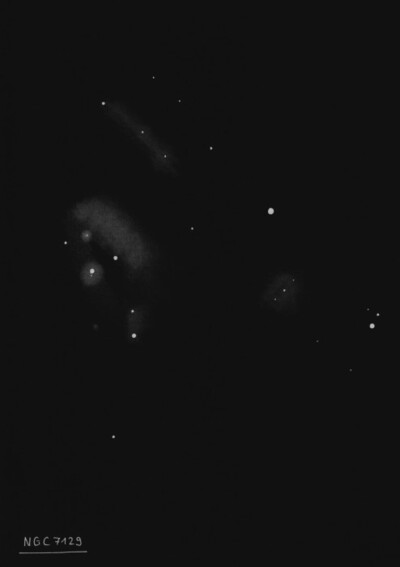
William Herschel discovered NGC 7129 = H IV-75 on 18 Oct 1794 (sweep 1063) and recorded "3 stars about 9m involved in nebulosity. The whole takes up a space of about 1.5' diam, 2 other stars of the same size and very near are not enclosed in the nebulosity." On 16 Sep 1798 (sweep 1079) he logged "3 stars about 9-10m involved in nebulosity; 2 sp stars very near them are free from that appearance. The nebulosity is of the milky kind and considerably strong. There is a small 4th stars in the nebulosity just north of the following one." John Herschel's description is similar: "a very coarse triple star involved in a nebulous atmosphere." On a second observation he gives the relative offsets for the 3 stars (A, B and C), which match my observation. His mean position for star A (southern star) is: 21 42 59.0 +66 06 12 (2000). Both father and son clearly refered only to nebulosity surrounding a few stars at the position given here.
Guillaume Bigourdan's position and description for IC 5134 = Big. 339, found on 15 Oct 1895, clearly applies to the nebulosity around star A only, as he thought NGC 7129 only applied to one of the northern patches. So, IC 5134 is part of NGC 7129. IC 5132 and IC 5133 refer to separate fainter reflection nebulae surrounding two mag 12 stars ~4' north-northwest, which were discovered by Isaac Roberts in 1895 on a photographic plate. Bigourdan's NGC 7133 = Big. 91, placed ~10' northeast of NGC 7129, is free of nebulosity and Harold Corwin concludes does not exist. The RNGC position for NGC 7129 is off by 1.7 minutes of RA and NGC 7133 is misidentified.
300/350mm - 13" (7/20/85): fairly bright with OIII filter but dims using a Daystar 300 filter. This nebulous region includes four or five stars and appears brighter around these stars. A small knot is at the north end and a second knot is at the south end.
400/500mm - 17.5" (10/17/98): fairly high surface brightness nebulosity ~3'x2', surrounding three mag 9.5-10.5 stars at 220x. At 280x, the brightest region surrounds the southern star (IC 5134) and the star 1' to its northeast. Just preceding this second star is a small knot that does not appear to be surrounding a star. The third star is 1' northwest the southern star and has the weakest halo. An additional pair of stars 1.5' and 2' southwest do not appear to be surrounded by halos. The entire group is encased in a diffuse glow and the surrounding region appears to be dusty. IC 5132/5133 are very weak nebulae surrounding two mag 12 stars ~5' NNW.
17.5" (9/23/89): fairly bright reflection nebula surrounded three bright stars. The brightest portion includes the southern star. Also a bright knot is at the north end and it does not appear to be surrounding a star (or the star is embedded).
Notes by Steve Gottlieb